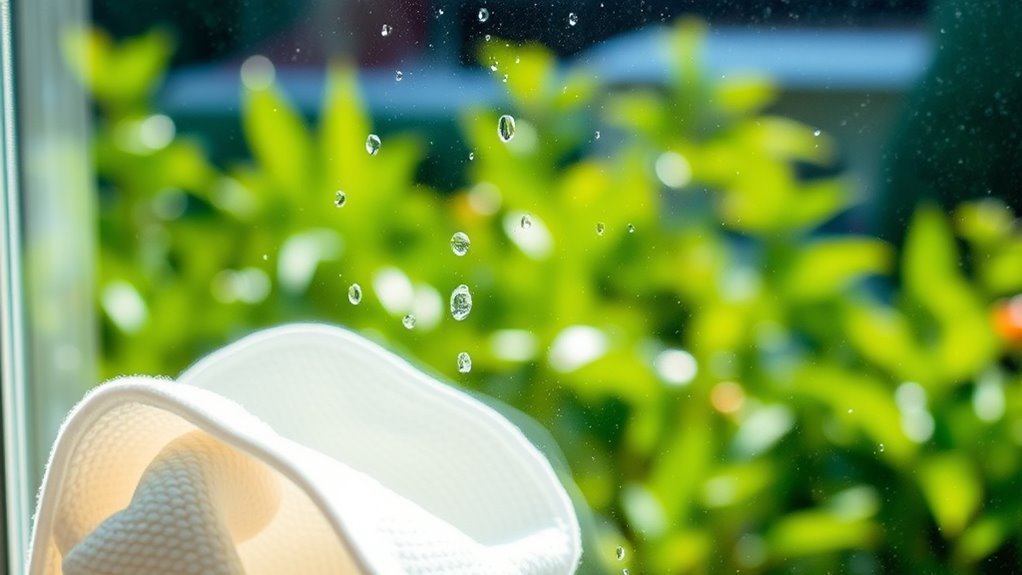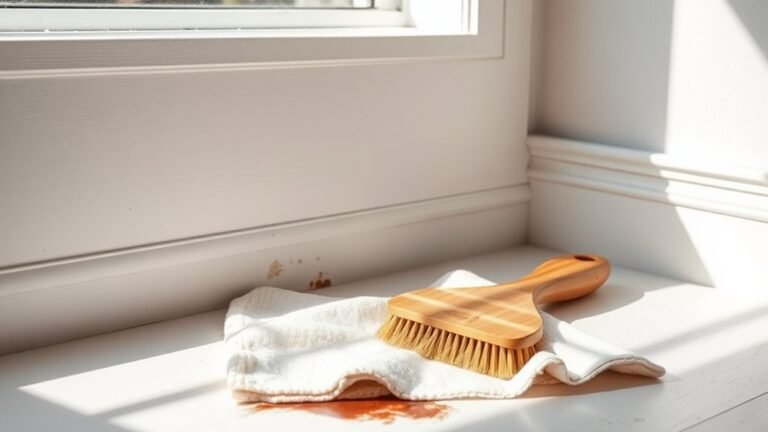Preventing Dirt Buildup on Window
To prevent dirt buildup on your windows, establish a regular cleaning routine every two to four weeks, focusing on both inside and outside surfaces during cooler times to avoid streaks. Use eco-friendly window-specific cleaners, avoiding harsh chemicals to maintain clarity. Consider applying protective films for easier cleaning and UV protection. Manage your outdoor environment by choosing low-maintenance plants and positioning hardscape away from windows. Installing quality screens can block airborne dirt effectively. These practical steps lay the foundation for cleaner, clearer windows and offer more strategies to explore.
Regular Cleaning Routines for Windows
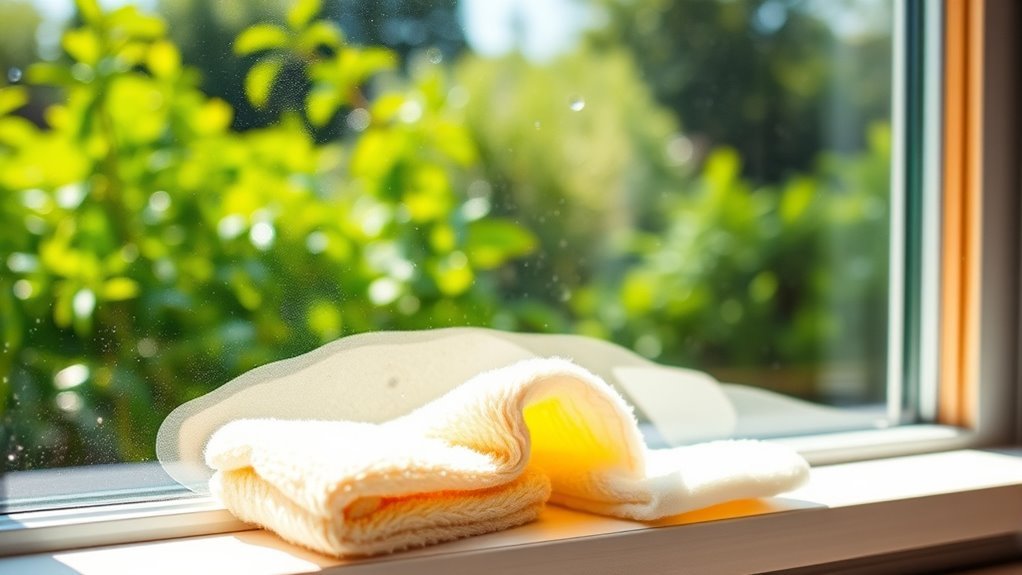
Establishing a consistent cleaning schedule is essential to prevent dirt buildup on your windows effectively. You should set specific intervals—typically every two to four weeks—depending on your local environment and exposure to elements. Integrating window maintenance into your routine prevents grime accumulation, making each session more manageable. Use a checklist to track cleaning dates and conditions, ensuring no window is overlooked. Focus on both interior and exterior surfaces, as dust and pollutants collect differently. Scheduling during cooler parts of the day minimizes streaking caused by rapid drying. By adhering to a structured cleaning schedule, you gain control over your environment, reducing labor and preserving window clarity. This disciplined approach allows you to maintain freedom from frequent, intensive cleanings while ensuring peak window performance and longevity. It is also important to choose the best weather for cleaning to achieve streak-free results and avoid quick drying.
Choosing the Right Cleaning Products
When selecting cleaning products for your windows, it’s essential to take into account their chemical composition and compatibility with different glass types and finishes. Harsh chemicals can degrade coatings or etch glass, so opt for formulations designed specifically for windows. Prioritize eco friendly options that balance minimal environmental impact with powerful cleaning agents to guarantee product effectiveness without compromising your values. Look for biodegradable surfactants and low-VOC solvents that cut through dirt and grime efficiently. Avoid ammonia or abrasive ingredients that may damage seals or tinting. Testing a small, inconspicuous area first can prevent unintended harm. By choosing the right product, you maintain clarity and durability, giving you the freedom to keep your windows spotless and their integrity intact over time. Additionally, using eco-friendly supplies helps ensure safe cleaning without scratching or damage.
Using Protective Window Films
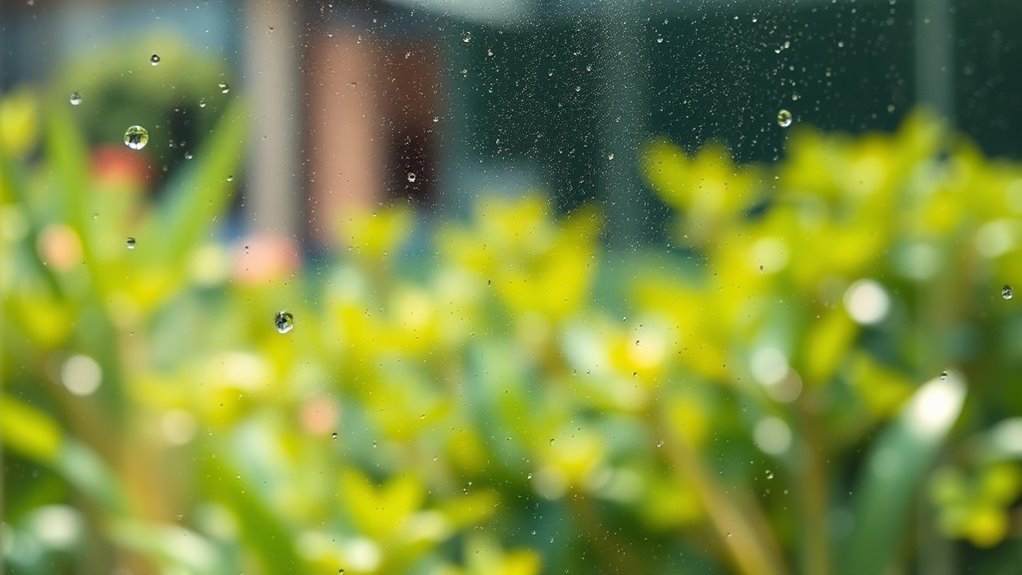
Although regular cleaning is essential, applying protective window films can greatly reduce dirt buildup and extend the lifespan of your glass surfaces. These films provide protective benefits such as UV resistance, scratch prevention, and easier cleaning. To maximize effectiveness, follow key installation tips: verify the window is spotless, apply the film evenly to avoid bubbles, and trim excess material precisely. Additionally, maintaining proper ventilation helps prevent moisture buildup on windows, which can contribute to dirt and mold accumulation on windowsills, complementing the benefits of protective films by reducing humidity levels.
| Protective Benefits | Installation Tips | Maintenance Advice |
|---|---|---|
| Blocks UV rays | Clean surface thoroughly | Wipe gently with microfiber |
| Prevents scratches | Use squeegee for smoothing | Avoid abrasive cleaners |
| Reduces dirt adherence | Trim edges carefully | Inspect film regularly |
Managing Outdoor Environment Around Windows
Since the condition of the outdoor environment directly impacts dirt accumulation on your windows, you’ll want to manage surrounding elements carefully. Begin with strategic landscape design: position hardscape elements like pathways and driveways away from windows to reduce dust and debris transfer. Opt for low-maintenance ground covers instead of bare soil, which can contribute to dirt buildup during wind or rain. Thoughtful plant selection is essential; choose greenery that minimizes leaf litter and pollen near window areas. Avoid trees or shrubs prone to shedding excessive debris or attracting pests. Regularly prune plants to maintain airflow and prevent moisture retention, which can cause dirt to stick. By combining deliberate landscape design and targeted plant selection, you’ll effectively reduce external dirt sources, keeping your windows cleaner and preserving your view without restricting your outdoor freedom. Additionally, trimming nearby plants can improve air circulation and sunlight exposure, helping to prevent moss and algae growth that can contribute to dirt buildup.
Installing Window Screens and Barriers
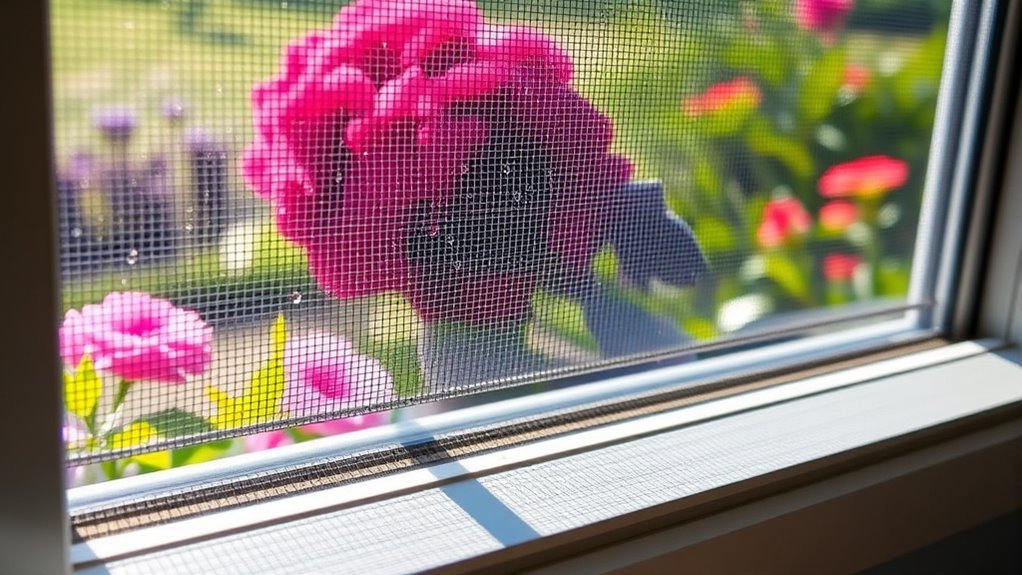
Three key types of window screens and barriers can greatly reduce dirt buildup by blocking dust, debris, and pests before they reach your glass surfaces. You’ll want to take into account mesh screens, magnetic screens, and retractable screens as your primary window screen types. Mesh screens, usually made from fiberglass or aluminum, offer durable filtration against airborne dirt. Magnetic screens provide easy installation and removal, ideal if you want flexible access while maintaining protection. Retractable screens, crafted from high-quality synthetic barrier materials, allow you to extend or retract them depending on weather or cleaning needs. Choosing the right barrier materials guarantees longevity and effective blockage without compromising airflow. Proper installation is essential—confirm tight seals around frames to prevent dust infiltration, giving you freedom from frequent window cleaning while enjoying fresh air.
Frequently Asked Questions
How Does Window Orientation Affect Dirt Accumulation?
You’ll find window orientation directly impacts dirt accumulation due to sunlight exposure and weather conditions. South-facing windows get more sunlight, which can bake on dust and grime, making buildup stickier. North-facing windows might stay damper longer, encouraging dirt to cling. Wind direction linked to orientation affects how much dust and debris hit your glass. Understanding this helps you predict when and where cleaning’s most needed, giving you more freedom to maintain clear views.
Can Indoor Plants Reduce Window Dust Buildup?
You can reduce window dust buildup by choosing specific plant types with strong dust absorption capabilities. Plants like spider plants, peace lilies, and Boston ferns excel at trapping airborne particles on their leaves, improving indoor air quality. Their leaf surfaces collect dust naturally, preventing it from settling on your windows. Regularly wiping leaves enhances this effect. So, incorporating these plants not only beautifies your space but also helps keep your windows cleaner with less effort.
Does Window Tinting Impact Dirt Attraction?
Window tinting offers several tint benefits, including effective glare reduction, which enhances visual comfort. While tinting primarily targets UV rays and heat, its slightly textured surface can influence how dirt settles, but it doesn’t greatly increase dirt attraction. You won’t notice much difference in grime buildup compared to untinted glass. So, if you want glare control and UV protection without extra cleaning hassle, window tinting’s a practical choice that keeps your freedom intact.
Are There Any Natural Remedies to Prevent Grime?
Did you know that essential oils can reduce bacterial presence by up to 99%? To naturally prevent grime, you can use homemade cleaners combining vinegar, water, and a few drops of essential oils like tea tree or lemon. These oils offer antimicrobial properties, breaking down dirt and preventing buildup without harsh chemicals. Applying this solution regularly keeps surfaces cleaner longer, giving you freedom from constant scrubbing while maintaining a safe, chemical-free environment.
How Often Should Window Seals Be Inspected?
You should set your window seal maintenance inspection frequency to at least twice a year—ideally in spring and fall. Regular inspections help you spot cracks, gaps, or wear before they compromise insulation and security. Check for moisture buildup or sealant deterioration, which can lead to drafts or damage. Keeping a consistent schedule guarantees your seals stay effective, giving you freedom from costly repairs and maintaining your window’s performance over time.
